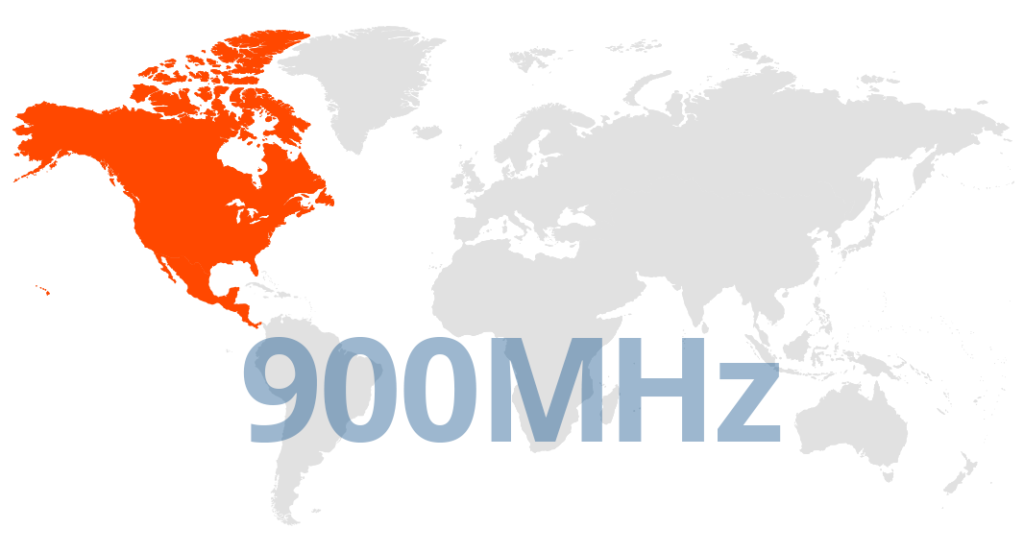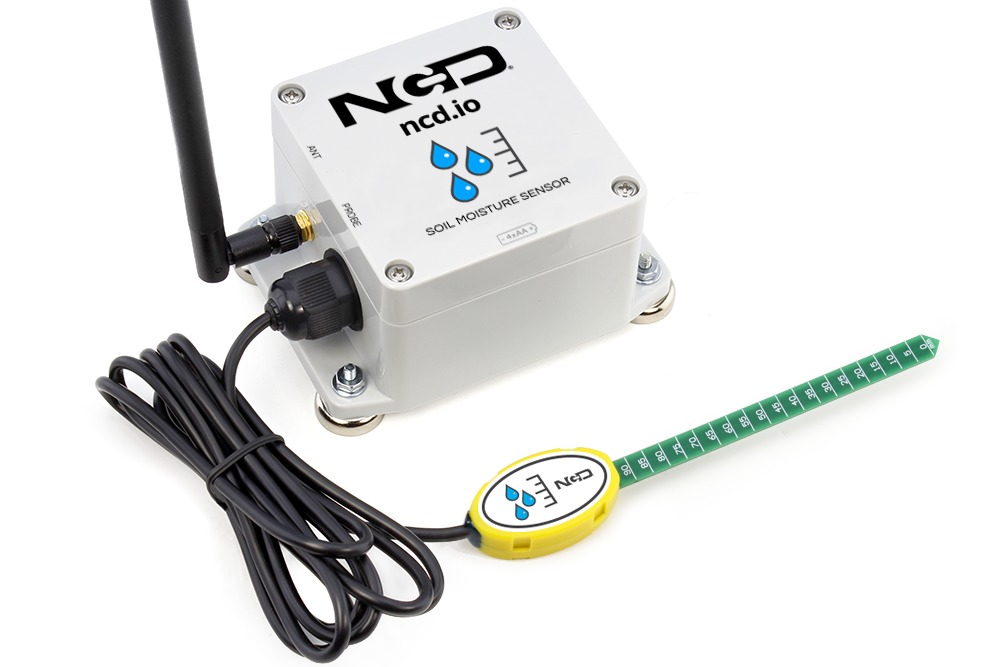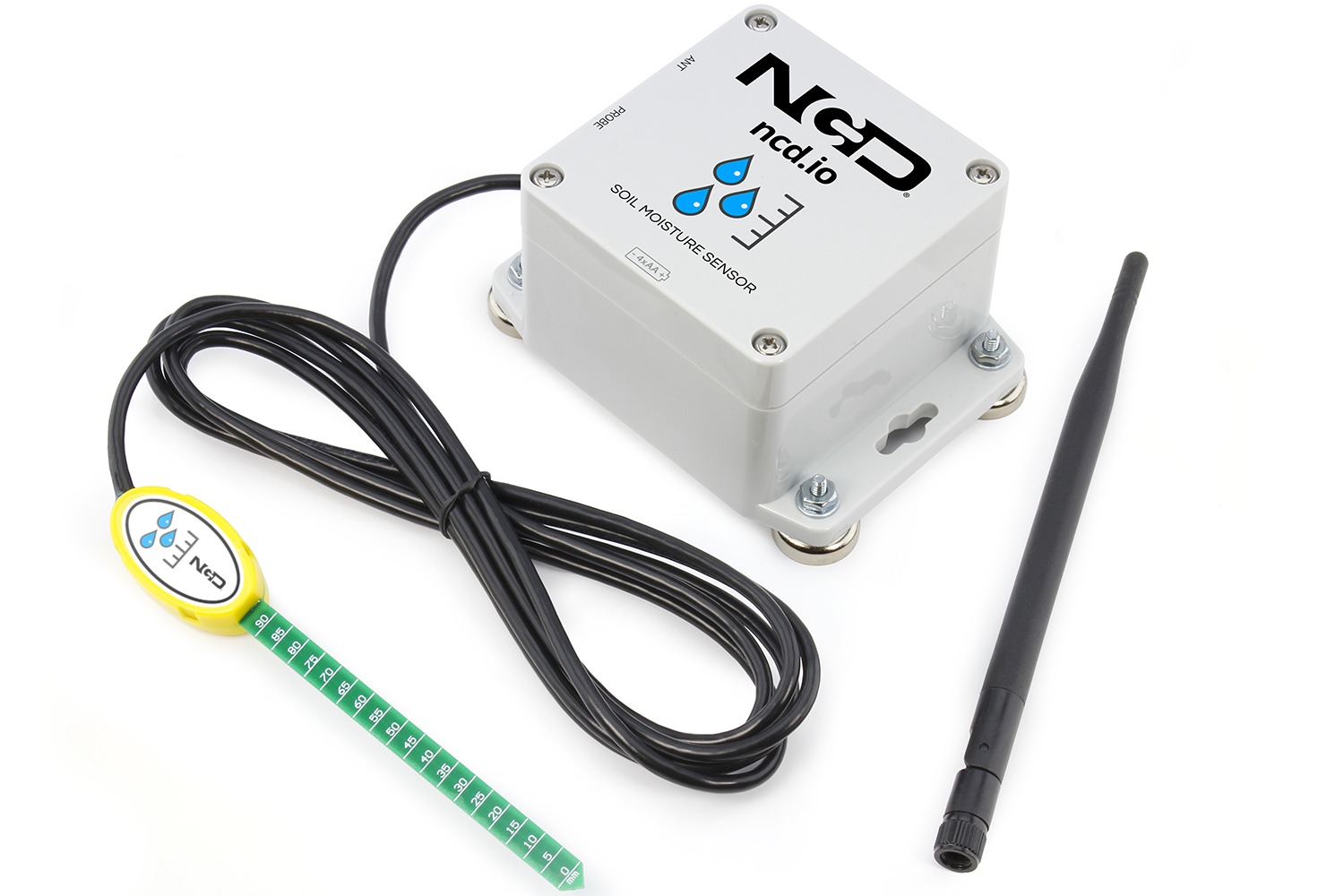Wireless IoT Soil Moisture Temperature EC Sensor
Highlights
- Wireless Soil Moisture Sensor for Indoor Outdoor Use
- Industrial Grade 1 Channel IoT Soil Moisture Sensor
- 10-bit Resolution ±2 LSB Absolute Accuracy
- Usable ADC Values of 0 (dry) to 830 (wet)
- Auto ADC Sample Transmission on Moisture Level Change
- Configurable 10% Analog Voltage Change Detection
- 2 Mile Line-of-Sight Range with On-Board Antenna
- Probe Does Not Corrode Over Time and Insensitive to Salinity
- Measures Volumetric Water Content (VWC)
- Measures Gravimetric Water Content (GWC)
- Interface to Raspberry Pi, Microsoft® Azure®, Losant, and More
- Example Software for Visual Studio and LabVIEW®
- Wireless Mesh Networking using DigiMesh®
- Open Communication Protocol for Easy Software Integration
- Includes Battery Level with Every Transmission
- Validates and Retries Lost Communication Packets
Long Range Wireless Sensors
Our long range wireless enterprise series sensors are an easy to use and reliable start to any data aggregation application. This video will demonstrate how they work, what they do, and how to use them.
Long Range IoT Wireless Soil Moisture Sensor
Introducing NCD’s Long Range IoT Wireless Soil Moisture Sensor, boasting up to a 2 Mile range using a wireless mesh networking architecture. This long range IoT wireless soil moisture sensor incorporates a 1 channel 10-bit ADC that samples soil moisture level at user defined intervals and sends a wireless transmission to remote gateways and modems. After sampling, this device goes to sleep to minimize power consumption and prolong battery life. This IoT Wireless Soil Moisture Sensor has an additional feature of detecting change in voltage every 7 seconds (user configurable) and sending out Soil Moisture levels if the change in Moisture level is greater than 10% (user configurable). To minimize power consumption, it sleeps during the time it is not checking for change in soil moisture level. Both of these features work together, supporting multiple application areas in one package. This Wireless IoT Soil Moisture Sensor output analog voltage. The voltage range is between 0 and 2.7V DC. Where output voltage 0 indicates that the soil is extremely dry and 2.7V indicates that the soil is extremely wet.
This wireless soil moisture sensor makes it possible to monitor soil moisture in multiple locations either outdoors or in greenhouses to monitor soil saturation conditions. Since this wireless soil moisture sensor is based on a analog to digital converter, you can expect to see about 800 different levels of soil moisture from 0 (dry) around 830 (wet). The included probe is 10cm and the included cable is 3 Meters in length.
Powered by just 4 AA batteries and an operational lifetime of 500,000 wireless transmissions, a 10 years battery life can be expected depending on environmental conditions and the data transmission interval. Optionally, this sensor may be externally powered.
IoT Security
We take IoT security very seriously, which is why we encrypt every IoT sensor, gateway, modem, and device in the NCD Enterprise product line. Encryption is much easier to manage than you might expect, as the encryption does not get in the way of using the device. We include a standard 128-Bit AES Encryption key with every device or we can help you integrate a new encryption key into all of your devices. All hardware devices must use the same encryption key. Once the keys are set, the hardware manages the rest for you, 100% in the background.
Wireless Range and Protocol
NCD long-range wireless IoT sensors use the DigiMesh® protocol from Digi.com. DigiMesh® was designed by THE industrial leader in secure wireless communications for industrial applications. DigiMesh® automatically hops data from gateway to gateway until it arrives at the desired destination. NCD IoT sensors are capable of a 2-Mile line-of-site communication distance with the included antennas and up to 28-mile range when using high-gain antennas.
Your IoT Sensor Data Belongs to You!
Your data belongs to YOU and it’s up to you to decide where you want your IoT sensor data to arrive. Don’t be bogged down by the limitations of proprietary cloud solutions, post the data where you need it most. We offer an open communications protocol so you can integrate NCD wireless transmitters into your own software. This allows integration of NCD IoT sensors into any control system or gateway you could ever imagine. Send data to a PC, Mac, or Linux computer, or a Raspberry Pi using NCD modems. Send data to popular cloud platforms such as Microsoft® Azure® IoT, Losant, and MQTT using NCD Micro Gateways. We can also help get data from NCD wireless IoT sensors to embedded platforms such as Arduino. We also offer sample code for Microsoft® Visual Studio, Node-RED, LabVIEW®, and Python. Our documentation fully breaks down the packet structure, so integration into other languages is possible. We may even be able to help, so please feel free to contact us if you are working with a platform not mentioned here.
The long range, price, accuracy, battery life and security features of Long Range IoT wireless soil moisture sensor makes it an affordable choice which exceeds the requirements for most of the industrial as well as consumer market applications.
Transmission Interval
This device sends data periodically, based on user-preset timing intervals.
This device sends data when sensor readings exceed preset limits.
Sensor Data Overview
NCD IoT Sensors send a lot more than just sensor data. For instance, a unique serial number is sent so you can always identify a particular sensor on the network. A Node ID is also included, which a single byte of data that you can use for anything, such as the floor of a building or to help identify which group a sensor belongs to. Also included in the data packet is a firmware version, battery level, and sensor type. This allows your software to positively identify and manage the health of NCD IoT wireless sensors. While signal strength data is also available, it is handled in a different way, and is not included in the sensor data packet (but rest assured, signal strength data for each sensor is available). Please see the Resources tab to see detailed information on the data structure of this device.
Good to know…
NCD wireless sensors transmit data and require a receiver. There are many options available for receiving data from NCD IoT devices, which will be discussed in much greater detail below. We highly recommend at least one USB Modem for the purposes of sensor configuration (available during checkout). Also, our LabVIEW software is typically used for advanced sensor configuration, which is located in the “Resources” tab above.
How long Will the Batteries really Last?
Most NCD IoT Sensors are rated for 300,000 to 500,000 transmissions until the batteries become so weak they are unreliable. You could spread these transmissions out over a 10 year period and send 50,000 transmissions per year. This would allow up to 136 transmissions per day, or about 5 transmissions per hour (for a 500K sensor, or 3 per hour for 300K sensor). If you only need the batteries to last 3 years, you could send 166,666 transmissions per year, or about 456 transmissions per day (about 19 transmissions per hour for a 500K sensor). As you can see, battery life is really up to you. By altering advanced settings in the NCD IoT sensor, you have control over longevity. Please note the 500,000 transmission rating is for premium alkaline batteries. NCD ships all sensors with premium Lithium batteries, which include a ultra-wide temperature range that typically lasts in excess of 600,000 transmissions for some sensor types. These batteries weigh less than half of alkalines, and they work in the freezer! A word of caution though, putting a sensor in configuration mode will drain the batteries very quickly. It’s important to configure your sensors and exit configuration mode as soon as possible or use a external power supply during configuration (if supported by the sensor). The table below indicates how many Transmissions Per Hour (TPH) your can expect from different sensors over a lifespan of up to 10 years.
| Battery Life: | 3 Months | 6 Months | 1 Year | 2 Years | 3 Years | 5 Years | 10 Years |
|---|---|---|---|---|---|---|---|
| 300K Sensor | 136 TPH | 68 TPH | 34 TPH | 17 TPH | 11 TPH | 6 TPH | 3 TPH |
| 400K Sensor | 180 TPH | 90 TPH | 45 TPH | 22 TPH | 15 TPH | 9 TPH | 4 TPH |
| 500K Sensor | 228 TPH | 114 TPH | 57 TPH | 28 TPH | 19 TPH | 11 TPH | 5 TPH |
| 600K Sensor | 272 TPH | 136 TPH | 68 TPH | 34 TPH | 22 TPH | 13 TPH | 6 TPH |
TPH = Transmissions per Hour
The Truth About Battery Life
Under the best of circumstances, the best non-rechargeable batteries commonly available today are limited to a 10 year non-working shelf life in a room temperature environment. Factors such as actual usage, temperature, and humidity will impact the working life. Be wary of any battery claims in excess of 10 years, as this would only apply to the most exotic and expensive batteries that are not commonly available. Also note that most battery chemistries are not rated for use in extreme temperatures. NCD only uses the best Non-Rechargeable Lithium batteries available today, which are also rated for use in extreme temperatures and have been tested by our customers in light radioactive environments. Lithium batteries offer a 10 year maximum expected shelf life due to limitations of battery technology. NCD will never rate sensor life beyond the rated shelf life of the best batteries available today, which is currently 10 years.
How Do I Change Settings and Examine Raw Sensor Data?
Using our long-range USB wireless modem, users can expect easy operation over a virtual COM port at 115.2K baud. Simply open the virtual COM port of the USB modem and watch data stream in. Optionally, we offer a Wireless receiver that operates over Ethernet. Data from NCD sensors will appear over TCP/IP on port 2101. Simply open a TCP/IP socket, port 2101, to the IP address of the Ethernet modem and see your data stream in to your local area network. We have developed LabVIEW® software for each sensor to change advance sensor settings using both Ethernet and USB modems. Alpha Station also allows display of sensor readings as well as limited configuration (this feature is still in development). Of course gateways are also available for sending data to popular cloud platforms such as Amazon® AWS® IoT, Microsoft® Azure® IoT, and Losant (more information below). We take software samples seriously, so be sure to to check out the “Resources” tab to see code samples for Raspberry Pi, Visual Studio, LabVIEW®, Arduino, Python, and more.
What Frequency Do I Need?
Range and Frequency of NCD Wireless Sensors
During purchase, you will see three frequency options. Not all options are legal for use in all areas, so it’s important to make the right selection during purchase. We will build your product and accessories based on the options chosen. Here, we will explain these options in much greater detail, but please check your local laws BEFORE purchase.
900MHz for North America (U.S., Canada, and Mexico)
If you are located in North America, the 900MHz Option will provide the longest range currently supported with the best penetration through walls, buildings, industrial equipment, and trees. This option is also the best choice for long range applications.

900MHz Wireless Sensor Range
The official Line of Sight rating for this option is 2 Miles with included antennas or 28 Miles with high-gain antennas. These distances are characterized for direct line of sight applications with no obstructions. Real-world range will vary greatly depending on surrounding buildings, trees, and other objects that may cause reflections or interfere with the transmission. 900MHz has excellent RF penetration characteristics, and we have successfully completed installations in excess of of a half mile on a automotive factory floor with active robots in between. We have also seen excellent penetration in mild radioactive installations making this a possible candidate for use in nuclear energy applications.
We suggest contacting Digi.com for a high-gain antenna recommendation if required. Please check your local laws before choosing this option.
868MHz for Europe Only

If you are located in Europe, the 868MHz Option is the longest range choice available at this time. This option offers better penetration through walls, buildings, trees, and industrial equipment than 2.4GHz. The official line of site rating for this option is 14.5km using 2.1dBi antennas. Please check your local laws before choosing this option.
2.4Ghz for Worldwide Use
The 2.4GHz option should be chosen if 900MHz and 868MHz are not legal for use in your country. This option is now certified for use worldwide, including Europe, United States, Japan, Australia, Brazil, and South Korea. Please check your local laws before choosing this option just in case 2.4GHz is not legal in your area.
Not Sure?
If you are unsure of which sensor option to choose, please contact us. We may be able to help determine which sensors are legal for use in your area.

Wireless Soil Moisture Sensor Applications
- Green House Soil Moisture Monitoring Application
- Wireless Plant Health Monitoring
- Smart Irrigation System
- Low Soil Moisture Change Alarm Application
- Create the perfect conditions for compost piles
- Protect concrete foundations by maintaining adequate soil moisture
- Push Soil Moisture Level To Cloud Services Like AWS and Azure
- Wireless Soil Moisture Sensor for Indoor Outdoor Use
Mechanical Drawing

Wiring Diagrams
Essential
Documentation Downloads
Not for use in outdoor applications or for use in excessive temperature conditions. Prolonged freezing will prevent batteries from functioning until thawed, using extended temperature range industrial batteries may improve the useful temperature range. Extended freezing applications should use a full-time powered solution. Prolonged exposure to extreme humidity conditions may damage this device. The sensing element is rated for use for 5 years and may be replaced. Exposure to high temperatures may cause the batteries to leak, causing permanent damage to this device. NCD Warranty does not cover battery corrosion or use in excessively smoky environments under any circumstances.


